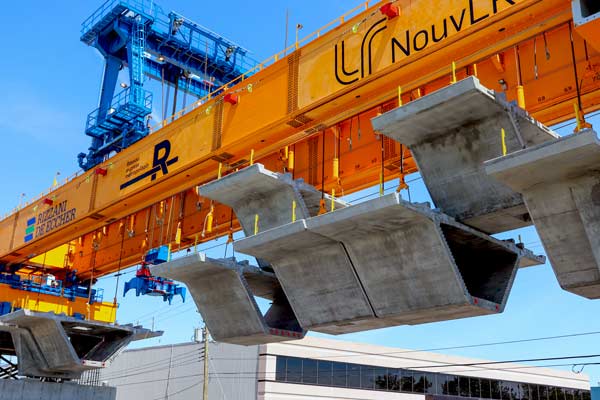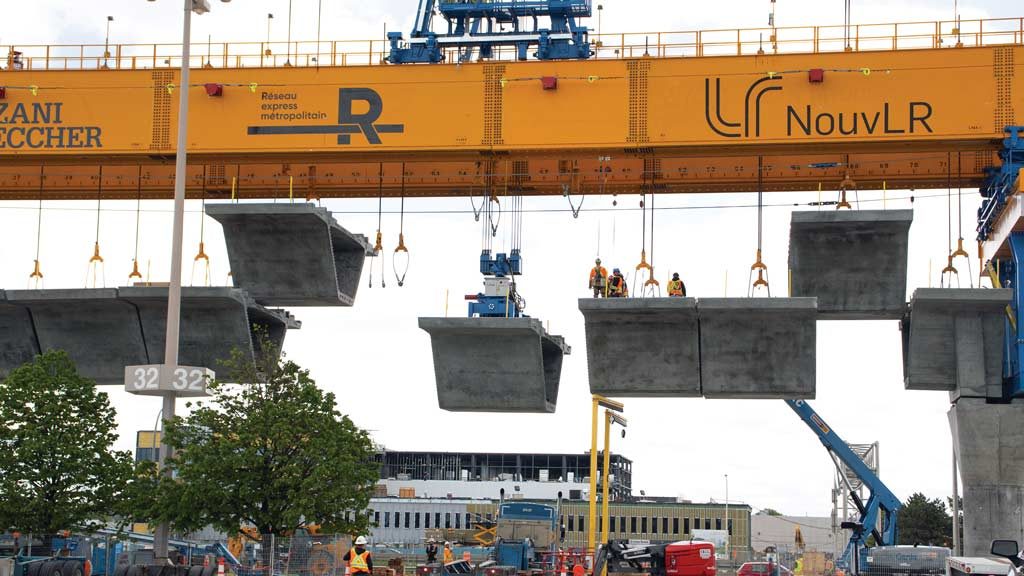They’re called Anne and Marie.
They weigh 580 tons, are 110 metres in length and each of them can support up to 600 megatons.
They’re the new launching gantries that are constructing the elevated parts of Montreal’s Reseau express metropolitain (REM) 67-kilometre, 26-station, light rail commuter rail network.
No, chuckles Stefan Balan, the REM official overseeing the operation on Montreal’s west island — serving the city’s western suburbs — “they’re not my daughters’ names.”
Rather, they’re named after the stations where the elevated sections of the network will end — Sainte-Anne-de-Bellevue on one line and Avenue Marie-Curie in the city’s research Technoparc, on the other.
“We baptized our launching gantries,” Balan continues. “We’re very fond of them.”
And they should be.
The gantries, built by DEAL, a subsidiary of Italian construction group Rizzani de Eccher S.p.A., are vastly expediting the construction of the network’s 366 spans, averaging 40 metres in length along 14.5 kilometre of what will be an elevated track.
While construction of the remote controlled REM, which will also serve other parts of the city and its southern or South Shore suburbs, has a time line for service to begin as early as 2021 (the west island sections will open at least a year later), expediting that timeline was only one consideration for using the gantries.

“Actually, we concentrated on the best technical solution for the project with the minimum impact on the environment,” Balan says. “I’m talking about noise, dust, vibration, the usual construction site nuisances and also the effect on the population, the traffic, the impact.”
The launching gantries have been used elsewhere but they’re a “first for Quebec,” Balan says. “It’s a proven method that has proven good results in other light rail projects.”
The official acknowledged the schedule is “aggressive…we like that in construction, it’s a challenge.”
But health and safety was another consideration.
“It means that we limit the time and we limit the extent of work at height, so when the workers work there they work in a very safe way,” Balan says.
Instead of using traditional cranes to lift each of the 4,102 precast segments (made by BPDL in Saint-Eugenede-Grantham near Drummondville, Que.) that make up the spans of the REM, the gantries can lift a series of segments and assist in fitting them together.
For the setup, each gantry proceeds along the REM footprint and uses the already in situ concrete piers to move from one span to another.
“Once it’s installed on the piers we don’t have to bring it down until the end of the job,” Balan says.
The difference in speed of installation is startling.
“The maximum speed which we can obtain with these launching gantries is pretty incredible from the point of view of a construction civil engineer,” explains Balan. “We’re talking about building a span in two days versus traditional methods which can vary somewhere between three weeks and more.”
Each gantry is composed of two long structural beams supporting the crane that rolls along rails. The crane — “we call it the winch,” Balan says — lifts each segment (which has a depth between 2.80 and 3.79 metres, a length of 9.30 metres and a height of three metres, weighing between 42.3 and 57.7 tons) from a flatbed truck (one segment per truck).
Once the segments are lifted and put in place they’re attached to a hanger on each side. Once the 11 or 13 segments that comprise each span are lined up, a row of epoxy glue is applied all around the joint to ensure water tightness, and then post-tensioning takes place via a DYWIDAG system.
Once the span is certified, hangers are detached and the gantry moves to the next pier. This is done by moving the gantry’s middle leg close to the front one. It’s secured on the pre-installed span and the leg in front moves in cantilevered fashion to the next pier where it’s fixed in place. The back leg is then advanced behind the middle leg, all in a “crawling movement,” Balan says. This process takes five hours.
Since November almost 700 segments have been pre-fabricated — “we’re a little bit ahead of our schedule,” says Balan. Installation began in June.
A dozen or so iron workers are needed to install the segments, and there’s a crane operator and mechanical support.
The REM’s contractor for infrastructure engineering, procurement and construction (EPC) is Groupe NouvLR comprised of SNC-Lavalin, Dragados Canada Inc., Groupe Aecon Quebec Ltee, Pomerleau Inc., EBC.











Why did it take so long to use this mechanical technology…..